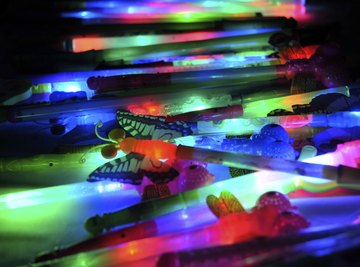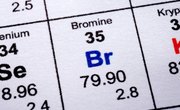
Glow sticks are a fun light toy for both children and adults, and these chemical lights can actually be made at home. With the right chemicals and supplies, you can make a glowing liquid that mimics the store-bought commercial brands. You'll need a number of chemicals -- the more unusual of which you'll need to find online -- distilled water, glass containers and safety gloves to complete this straightforward do-it-yourself project.
- Sodium carbonate
- Luminol
- Ammonium carbonate
- Copper sulfate pentahydrate
- Distilled water
- Hydrogen peroxide (3-percent strength)
- Clear glass containers
- Latex gloves
- Safety glasses
The luminol method is a true chemical light. TCPO or bis (2,4,6-trichlorophenyl) oxalate is used to make glow sticks, and its fluorescent colored dyes are made to glow by adding energy.
Prepare your work area by ensuring that it is well-ventilated, free of spills and away from flames. Put on your safety glasses and gloves.
Pour 1 liter of distilled water into a glass container. Slowly add 4 grams of sodium carbonate with 0.2 gram of luminol, 0.5 gram of ammonium carbonate and 0.4 gram of copper sulfate pentahydrate.
Mix the chemicals thoroughly, and set aside the container.
Pour 1 liter of distilled water into a second glass container. Add 50 milliliters of 3 percent hydrogen peroxide and stir well.
Put the contents of both containers into a third glass jar. Pour them together slowly to create a blue glowing liquid.
Things You'll Need
Tips
References
About the Author
John Mitchell is an expert in all things technology, including social media and smart phones. He is a news ninja for Qwiki, bringing the latest news on the interactive platform. Mitchell graduated from the University of Sedona with a master's degree in pastoral counseling psychology and authored the book, "No More Taxes."
Photo Credits
Antenore/iStock/Getty Images
